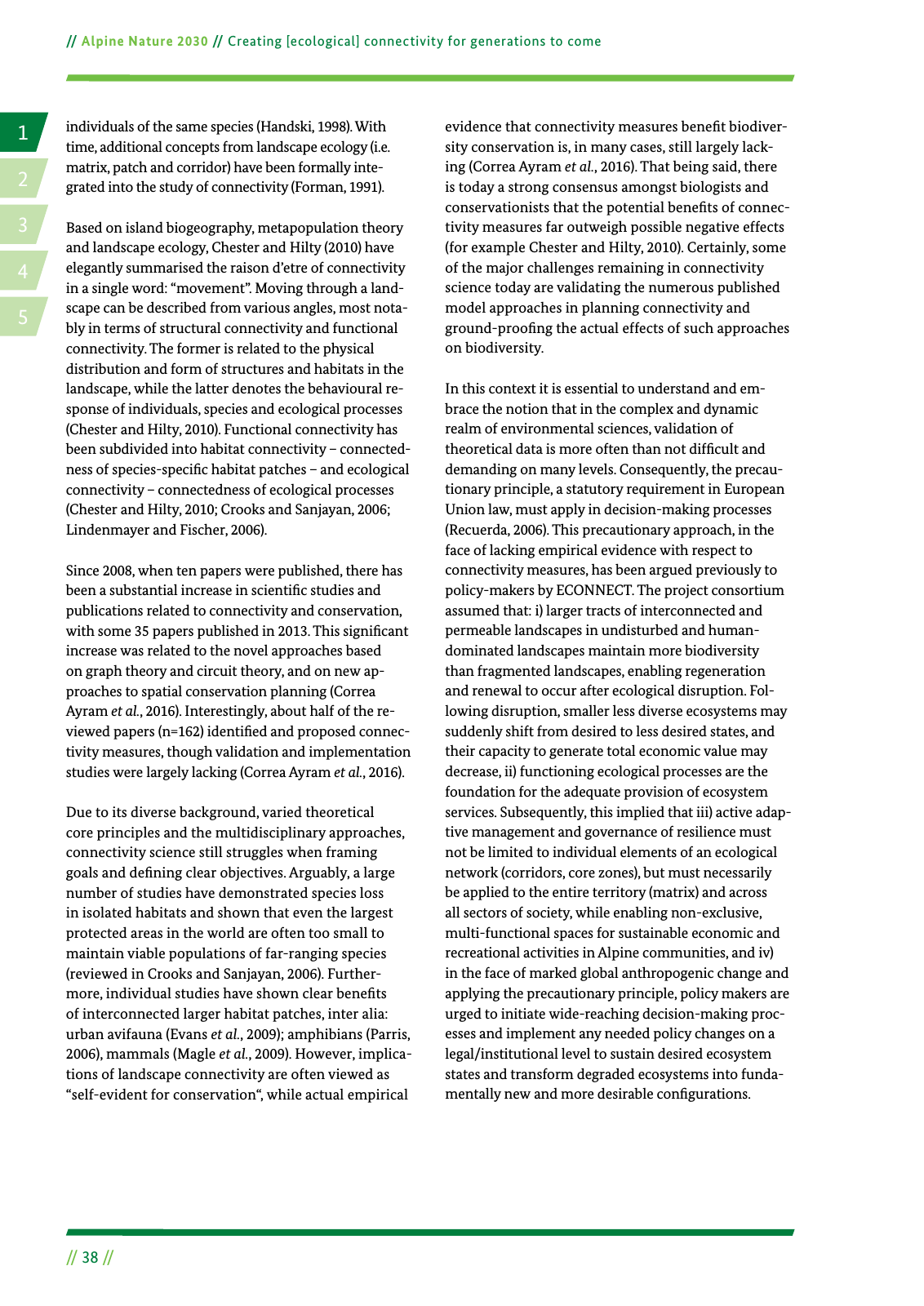14 2 5 3 38 Alpine Nature 2030 Creating ecological connectivity for generations to come individuals of the same species Handski 1998 With time additional concepts from landscape ecology i e matrix patch and corridor have been formally inte grated into the study of connectivity Forman 1991 Based on island biogeography metapopulation theory and landscape ecology Chester and Hilty 2010 have elegantly summarised the raison d etre of connectivity in a single word movement Moving through a land scape can be described from various angles most nota bly in terms of structural connectivity and functional connectivity The former is related to the physical distribution and form of structures and habitats in the landscape while the latter denotes the behavioural re sponse of individuals species and ecological processes Chester and Hilty 2010 Functional connectivity has been subdivided into habitat connectivity connected ness of species speci c habitat patches and ecological connectivity connectedness of ecological processes Chester and Hilty 2010 Crooks and Sanjayan 2006 Lindenmayer and Fischer 2006 Since 2008 when ten papers were published there has been a substantial increase in scienti c studies and publications related to connectivity and conservation with some 35 papers published in 2013 This signi cant increase was related to the novel approaches based on graph theory and circuit theory and on new ap proaches to spatial conservation planning Correa Ayram et al 2016 Interestingly about half of the re viewed papers n 162 identi ed and proposed connec tivity measures though validation and implementation studies were largely lacking Correa Ayram et al 2016 Due to its diverse background varied theoretical core principles and the multidisciplinary approaches connectivity science still struggles when framing goals and de ning clear objectives Arguably a large number of studies have demonstrated species loss in isolated habitats and shown that even the largest protected areas in the world are often too small to maintain viable populations of far ranging species reviewed in Crooks and Sanjayan 2006 Further more individual studies have shown clear bene ts of interconnected larger habitat patches inter alia urban avifauna Evans et al 2009 amphibians Parris 2006 mammals Magle et al 2009 However implica tions of landscape connectivity are often viewed as self evident for conservation while actual empirical evidence that connectivity measures bene t biodiver sity conservation is in many cases still largely lack ing Correa Ayram et al 2016 That being said there is today a strong consensus amongst biologists and conservationists that the potential bene ts of connec tivity measures far outweigh possible negative effects for example Chester and Hilty 2010 Certainly some of the major challenges remaining in connectivity science today are validating the numerous published model approaches in planning connectivity and ground proo ng the actual effects of such approaches on biodiversity In this context it is essential to understand and em brace the notion that in the complex and dynamic realm of environmental sciences validation of theoretical data is more often than not dif cult and demanding on many levels Consequently the precau tionary principle a statutory requirement in European Union law must apply in decision making processes Recuerda 2006 This precautionary approach in the face of lacking empirical evidence with respect to connectivity measures has been argued previously to policy makers by ECONNECT The project consortium assumed that i larger tracts of interconnected and permeable landscapes in undisturbed and human dominated landscapes maintain more biodiversity than fragmented landscapes enabling regeneration and renewal to occur after ecological disruption Fol lowing disruption smaller less diverse ecosystems may suddenly shift from desired to less desired states and their capacity to generate total economic value may decrease ii functioning ecological processes are the foundation for the adequate provision of ecosystem services Subsequently this implied that iii active adap tive management and governance of resilience must not be limited to individual elements of an ecological network corridors core zones but must necessarily be applied to the entire territory matrix and across all sectors of society while enabling non exclusive multi functional spaces for sustainable economic and recreational activities in Alpine communities and iv in the face of marked global anthropogenic change and applying the precautionary principle policy makers are urged to initiate wide reaching decision making proc esses and implement any needed policy changes on a legal institutional level to sustain desired ecosystem states and transform degraded ecosystems into funda mentally new and more desirable con gurations

Hinweis: Dies ist eine maschinenlesbare No-Flash Ansicht.
Klicken Sie hier um zur Online-Version zu gelangen.
Klicken Sie hier um zur Online-Version zu gelangen.